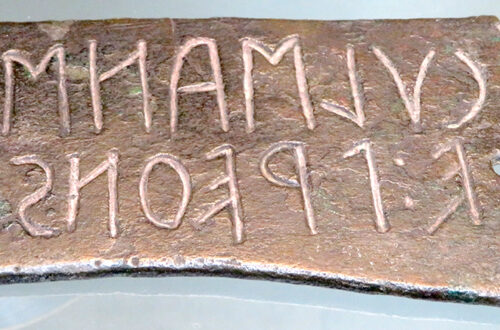
Leo Wiener, a pioneer halfway through
This book of the fairly known american historian about forgeries of Greek and Latin texts of late antiquity – though easily matching our history revision – has not been mentioned so far by any of our authors:

Leo Wiener (1920) Contributions towards a History of Arabico-Gothic Culture; vol. III: Tacitus’ Germania and other Forgeries (Philadelphia)
I start rightaway with the conclusion of the chapter on Tacitus and his Germania (p. 299):
“The utter worthlessness of the Germania is patent, beyond any possibility of defence. Only the mentally blind will defend it, even as the nineteenth century forgeries, such as the notorious Koeninginhof Manuscript still find advocates. It is sad to contemplate that Germanic history and allied subjects are based on the Germania and the Getica, two monuments of conscious fraud and unconscious stupidity, the result oft the first flower of Arabic romance, which led to TheThousand-and-One-Nights. One may as well reconstruct history from this latter work, as draw any historical conclusions whatsoever from the Germania and the Getica.”
In his book review Victor Chapot (1921) writes:
“The author has shown the caution with which one must treat the writers of the lower Latinity: Cassiodorus and Bede, Ammianus Marcellinus and Gregory of Tours, Rufinus, etc., some of their works are apocryphal from beginning to end. The Arabic interference before the translation can be felt everywhere.
The Gothic Bishop Wulfilas is an imaginary being that no author mentions at the time when the Goths were converted. Even before Wiener’s criticism, he was a nebulous figure.
Likewise, Jordanes was not known any further, only his Getica was considered a valuable summary of the lost work of Cassiodorus on the Goths. But it is a fake of the 8th / 9th. Century without the slightest historical basis, pieced together from Persian, Syrian and Arabic fragments of an unknown ‘Antiquitas’, the great influence of which we find again in the Pseudo-Berosos, in the Hunibald of Trithemius, and – worst of all – in the Germania of Tacitus.”
Wiener says in his forword: “The next volume will give the proof that the Physiologus is of Syrio-Arabic origin, and incidentally will confirm the fact that Gregory of Tours has come down to us highly interpolated and that a series of other works, ascribed to Rufinus and others, are eighth century forgeries.”
You can clearly see the phantoms Wiener is fighting with. If the list of participants at the Nicene Council (325) is real, then Wulfilas is also a real person, says Wiener, but then gradually realizes that all other ‘facts’ handed down about this bishop and his environment are falsified or incorrectly adopted from other scriptures.
“There was no escape — the Spanish Goths of the eighth and ninth centuries not only furnished wholesale literary and documentary frauds to the western world, but also inspired interpolations and more important frauds in Greek literature.”
The Arab writers were not uninvolved …
But the eighth century, especially Syro-Arab texts, remains a stronghold which he does not give up. And here lies Wiener’s weakness, which, by the way, he himself recognized. Given the enormity of his discoveries, we may excuse him. Yet, that doesn’t help us today.
It is surprising to me that such clear evidence of the fact that Tacitus, Jordanes, etc. are forged, which others like Hochart, Johnson, Ross, Baldauf … had written before him with regard to Tacitus, did not produce any pupils or successors. Was it because of the insurmountable chronological deadlock?
But if 700 years or even a millennium between antiquity and the Renaissance can be cut out, when the classical texts come so much closer to the actual inventors (as we have shown during the last twenty years) then the perspective becomes less dizzying; the earthquake evoked by Wiener for comparison, which shatters his Weltanschauung, becomes more plausible.
With this brief reference I draw attention to Wiener and his work. Reading the book is at times very gratifying and even amusing, for example when the narrative of the elks which have no joints and therefore cannot lie down to sleep, is linked to certain Suebi tribes; or when Hertha-Nertha carried along in a chariot is brought back to its roots in Greek myth …
Note on Leo Wiener:
Leo Wiener (1862–1939) American historian and linguist, born in Bialystok (Russian Poland) to Jewish parents, but later a Unitarian Christian. Multilingual (they said he could speak 30 languages), studied in Warsaw and Berlin; lectured at Harvard on Slavic literature since 1896. He translated Leo Tolstoy’s works into English.
As for the Getica of Jornandes, see e.g. Jacob Grimm on Jornandes und die Geten 1866. Treatises of the Royal Prussian Academy of Sciences in Berlin.
Jacob Grimm was well aware that Adelung regards Ovid’s Getic verses as “mere poetic boasting”. But a critical view of those lore does not mean that the extent of the forgery was understood. On the contrary, the historical truth of these texts was increasing with every discussion among scientists.
Literature
Leo Wiener, Contributions toward a History of Arabico-Gothic Culture;
Vol. III: Tacitus, Germania and other Forgeries, 1920
link: https://archive.org/stream/cu31924088053396/cu31924088053396_djvu.txt
Victor Chapot in Revue des Études Anciennes, Année 1921 23-3 pp. 253-255
about Hochart see here in the library: Hochart’s investigation of Tacitus
also in the library here: Johnson, ein radikaler Chronologiekritiker
as well as: Johnson’s postumous work finally translated into German
Ross, J. W. (1878): Tacitus and Bracciolini. The Annales forged in the XV. century (London)
https://books.google.co.uk/books?id=KPrfAAAAMAAJ&pg=PR11&hl=de&source=gbs_selected_pages&cad=2#v=onepage&q&f=false
Baldauf, R. see Angelika Müller in Zeitensprünge 4/1996, Die Geburt der Paläographie, S. 533; Uwe Topper (1998): Die Große Aktion, S. 16-20 (here in the archive); Rainer Schmidt: Nachlese zu Robert Baldauf (2021)




